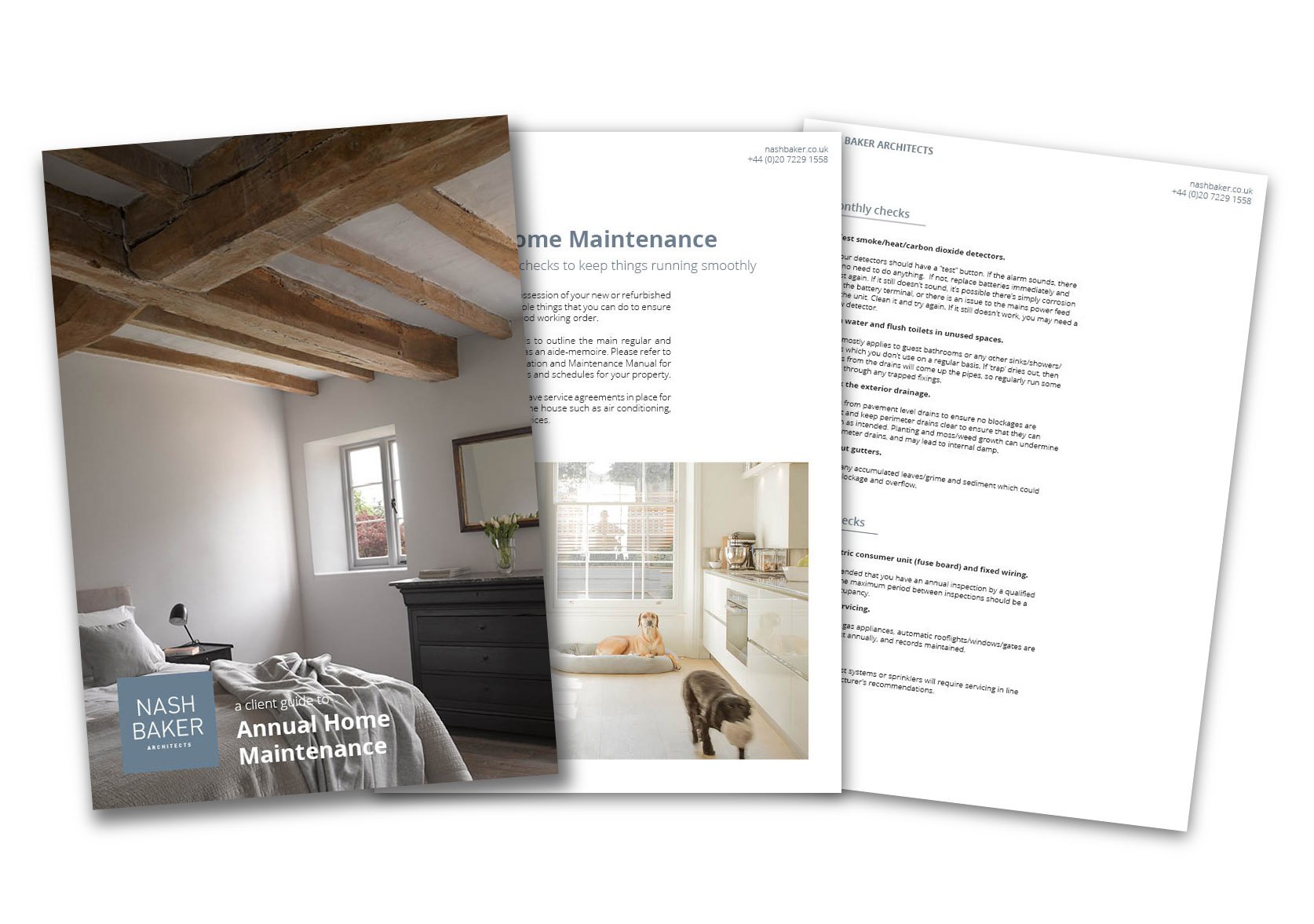A Client Guide to Annual Home Maintenance
You've invested a lot of time, effort and not to mention money, in creating your perfect home so scheduling regular maintenance checks will ensure it stays in good working order for years to come. From simple monthly checks such as testing smoke detectors to annual servicing of appliances, it's all set out in this guide, along with inspections and repairs to carry out in each season of the year.
Please read on or click here to open as a pdf.
Regular & periodic checks to keep things running smoothly
Now that you have taken possession of your new or refurbished home there are several simple things that you can do to ensure that the building stays in good working order.
The purpose of this guide is to outline the main regular and periodic home-owner tasks as an aide-memoire. Please refer to your full Homeowner’s Operation and Maintenance Manual for fuller details on specific items and schedules for your property.
Please note that you should have service agreements in place for the more technical items in the house such as air conditioning, security and audio-visual services.
Monthly checks
Test smoke/heat/carbon dioxide detectors.
Your detectors should have a “test” button. If the alarm sounds, there is no need to do anything. If not, replace batteries immediately and test again. If it still doesn’t sound, it’s possible there’s simply corrosion on the battery terminal, or there is an issue to the mains power feed to the unit. Clean it and try again. If it still doesn’t work, you may need a new detector.
Run water and flush toilets in unused spaces.
This mostly applies to guest bathrooms or any other sinks/showers/baths which you don’t use on a regular basis. If ‘trap’ dries out, then smells from the drains will come up the pipes, so regularly run some water through any trapped fixings.
Check the exterior drainage.
Lift lids from pavement level drains to ensure no blockages are present and keep perimeter drains clear to ensure that they can function as intended. Planting and moss/weed growth can undermine the perimeter drains, and may lead to internal damp.
Clean out gutters.
Remove any accumulated leaves/grime and sediment which could cause a blockage and overflow.
Annual checks
Mains electric consumer unit (fuse board) and fixed wiring.
It is recommended that you have an annual inspection by a qualified electrician. The maximum period between inspections should be a change of occupancy.
Appliance servicing.
Ensure that all gas appliances, automatic rooflights/windows/gates are serviced at least annually, and records maintained.
Fire systems.
Fire curtains, mist systems or sprinklers will require servicing in line with the manufacturer’s recommendations.
Spring checks
Inspect the exterior of your home.
Is any paint chipping? Are there any hairline cracks appearing? Have any timber elements been weather damaged following winter? Are there any holes in your brickwork? A good silicone or filler can address a number of minor issues, or more thorough re-pointing or redecoration may be required.
Clear dead plants/shrubs from the house.
Often, the best time to remove vegetation and undertake tree surgery is in early spring. Check if any of the trees in your curtilage are protected by Tree Preservation Orders before commencing works.
Inspect roofing for damage, leaks, etc.
Repair as needed; if you notice any slipped/broken tiles, cracked lead roofing, or issues with single-ply membranes, then it may be necessary to call in a professional roofing company if this work isn’t still covered under warranty.
Summer checks
Check grout in bathrooms, kitchen, etc;
Repair as needed. This will prolong the life of your tiled surfaces and ensure that moisture cannot track behind your tiling/stonework.
Inspect plumbing for leaks, clean aerators on taps.
Go around to all your taps and toilets and check for any small leaks or limescale build-up. Aerators on taps can often be removed with a special key, or you can apply limescale remover on a poultice for a couple of hours.
Take care of any rodent/insect problems you may have.
Look for signs of rodent and insect damage throughout the property and garden, and appoint specialist pest controllers if required.
Clean and repair deck/terraces as needed.
Stonework generally just needs a good washing; albeit jet washing should be avoided on all stonework as it can abrade the surface leading to longer term damage. Instead, use an approved stone cleaning fluid (check your homeowner’s manual for specific details) with a stiff broom. A timber deck may also need minor repairs and re-staining to maximise its lifespan.
Clean and review windows.
Summer is a good time to review windows as the clement weather makes any necessary repairs easy to undertake, and provides a good environment for putty and paint to set.
Autumn checks
Get heating system ready for winter.
Make sure air vents are open and not blocked by furniture; this will ensure the property can ‘breathe’ and prevents condensation build-up. Get the boiler serviced, flush underfloor heating system and rebalance if necessary, bleed all radiators.
Review external water supplies.
Check all external taps have insulating sleeves fitted, and garden sprinkler systems are turned off or set into winter mode.
Get chimney cleaned.
If you have a coal or wood burning stove, this should be done once a year to any operational chimney. If you have a gas fire, this is probably not necessary, but you should check with the manufacturer’s instructions for guidance on this.
Test sump pump.
If you have one installed within your basement, then autumn is an opportune time to undertake tests and service.
Purchase winter equipment.
Have pavement salt and a shovel ready for the most inclement of winter weather.
Winter checks
Landscape checks.
Ensure that plants are covered and protected from frost where necessary
Keep pathways clear.
Regularly clear ice and snow from main pathways to ensure that these are kept safe and clear of moss/algae growth.
Use background ventilation.
If you have them, ensure that window trickle vents and air bricks are clear and open, even through winter. This will prevent unwanted moisture build-up and condensation, and ensure that the building breathes, thus reducing the opportunity for mould growth.
To save this guide for future reference, download by clicking on the image above.
Resources and further reading
Please note: this is an overview guide of some of the most pertinent areas for maintenance and assessment – please refer to your full Homeowner’s Operation and Maintenance Manual for fuller details on specific items and schedules for your property.
This Client Guide is based on information current at the time of writing. It has been prepared by Nash Baker Architects for the purpose of general information and is not intended to be an exhaustive treatment of the subject. Each project is different, and it will be necessary to discuss details on a case by case basis. If you have any queries or require further clarification of any of the points addressed in this Client Guide, please do not hesitate to contact us.
© Nash Baker Ltd. 2020

